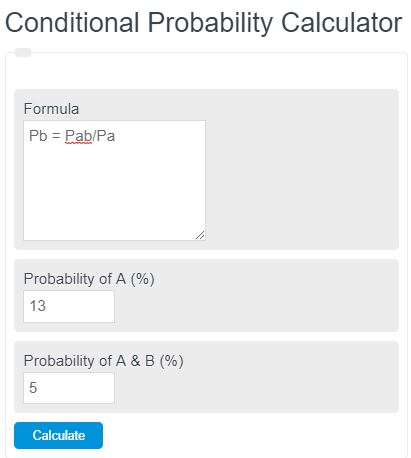Enter the chance of event A occurring and the change of both A and B occurring into the calculator. The calculator will determine the probability of event B occurring.
Conditional Probability Calculator
The following formula can be used to calculate the probability of an event occurring.
Pb = Pab/Pa
- Where Pb is the probability of event B occurring
- Pab is the probability of both A and B occurring
- Pa is the probability of event A occurring
To calculate the conditional probability, divide the probability of both A and B by the probability of A.
Conditional Probability Definition
Conditional probability is a mathematical concept that measures the likelihood of an event occurring, given that another event has already occurred. It is denoted as P(A|B), which represents the probability of event A happening, given that event B has already occurred.
To understand conditional probability, it is crucial to comprehend the concept of independence. Two events are considered independent if the occurrence of one does not affect the probability of the other occurring. On the other hand, if the occurrence of one event impacts the probability of another event, they are dependent.
Conditional probability allows us to calculate the probability of dependent events accurately. By utilizing prior information or knowledge about an event, we can refine our predictions and make more informed decisions.
How to calculate a conditional probability?
How to calculate a conditional probability?
- First, determine the probability of a
This is the percent chance of the event a happening.
- Next, determine the probability of Pab
This is the chance of both events A and B both occurring.
- Finally, calculate the chance of B
Calculate the probability of B using the information from steps 1 & 2, along with the equation presented above.
FAQ
What is the difference between conditional probability and independent events?
Conditional probability refers to the probability of an event occurring given that another event has already occurred, indicating a dependency between the two events. Independent events, on the other hand, are those where the occurrence of one event does not affect the probability of the other occurring.
How can understanding conditional probability help in real-life situations?
Understanding conditional probability can help in making more informed decisions in various real-life situations, such as risk assessment, medical diagnosis, and financial forecasting, by considering the likelihood of events based on prior occurrences.
Are there any limitations to using conditional probability?
Yes, the accuracy of conditional probability calculations depends on the accuracy and relevance of the prior information used. Misinterpretation or lack of data can lead to incorrect conclusions. Additionally, it assumes a causal relationship between events that may not always exist.
Can conditional probability be applied to complex events involving more than two outcomes?
Yes, conditional probability can be extended to complex events involving multiple outcomes by using more sophisticated formulas and approaches, such as Bayes’ theorem, to calculate the probability of an event based on multiple conditions or prior events.

